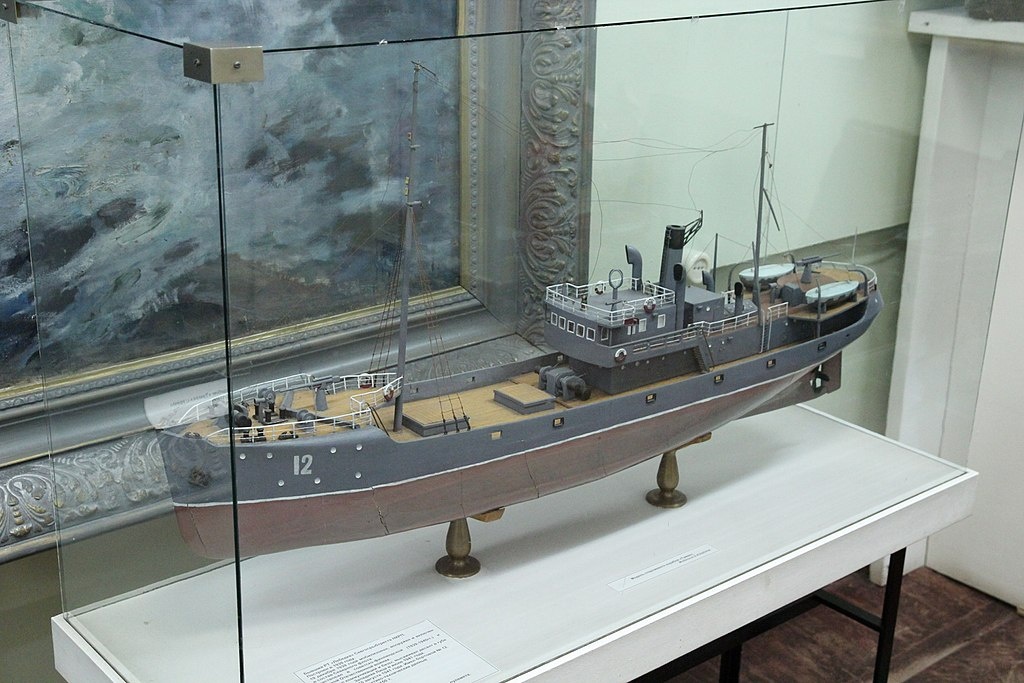
A model of the Tuman.
The Type 1934-class Z4.
It is the 10th of August, 1941. The Red Army’s front is
collapsing and the Germans are closing on the most important cities of the
USSR.
But we aren’t talking about that today. Our attention is
drawn to the Barents Sea, 15 miles northwest of Kildin Island. There sails the
hero of our story, the lone lightly armed naval trawler
Tuman.
On the horizon, the little ship sights the worst thing she
ever could have encountered: three German destroyers. The Z4 Richard Beitzen,
the Z10 Hans Lody, and the Z16 Friedrich Eckoldt are rapidly closing in on her
position. Each displaces twice as much as the little patrol boat and is armed
with four 5-inch guns that seemed like weapons of mass destruction when
compared to the Tuman’s two 45 mm cannons and light machine guns.
Running is out of the question, as her top speed of 9 knots
is only a fourth of the destroyers’. She has no options left but to face her opponents
and give them what she has. She lays down a smoke screen and begins evasive
action.
The destroyers close to five nautical miles and open fire.
She is prevented from returning fire due to her aft gun being knocked out
almost immediately. She takes eleven 5-inch shells over the course of the
battle. Her captain and commissar are both killed. Her flag is shot down from
the mast. She is, by all intents and purposes, defenseless.
She is not dead yet, however. The flag is raised again and
her crew continues to desperately work to keep her alive just a little longer.
They all know by now that she is going to sink, but they are going to make sure
that the Germans have to work all that much harder to kill her.
On Kildin Island, the shore batteries had been malfunctioning,
but no longer. As the Tuman slowly slips beneath the waves, the shore batteries
open fire. The destroyers, hoping to avoid damage, are forced to retreat from
the now-operational cannons. The battle is over.
Of the 52 sailors on the trawler, only 15 died that day.
Upon returning to shore, every one of the survivors is presented with tributes
from the citizens of Murmansk. When the Alyosha Monument was erected there in
1974, a capsule of seawater from the spot of her final stand was placed inside
of it.
Even today, as Russian warships pass over the spot where she
sank, they dip their flags and blast their horns in salute to the brave patrol
boat that faced down the Kriegsmarine.
While you can meet some abbreviation for ship classes in
Russian-language literature (like LK for battleship, EM for Destroyer, etc.),
they were never “officially” systemized. During WWII only
“Official” abbreviation used were “SKR” (for picket ships),
“TSch” (for sea-going minesweepers) and “BTSch” (for large
sea-going minesweepers), and “MO” (for submarine chasers). Another
note: “SKR” class was VERY different in its subclasses. One group was
armed trawlers and steamers with a mix of 45-mm, 76-mm, and up to 102-mm guns,
light AA, some sub chasing equipment, etc. – were used extensively for
close-to-coast escort duties. Two (“Tuman” (“Fog”) and
“Passat”) were sunk in surface engagements with German destroyers of
Arctic group, where they had no chances at all. Another story were SKR’s of
“Bad Weather” class. Specially built, excellently armed, and
well-equipped, they were closer to frigate/corvette/torpedo boat classes, than
to “picket ships”. Built in 1920’s-30’s, multiple units had “Bad
Weather” names – “Storm”, “Snowstorm”,
“Darkness”, “Strong Wind”, etc. They had 2 120-mm guns, 2
small guns, 1 3-tube 533-mm torpedo apparatus, AA’s, plenty of depth charges.